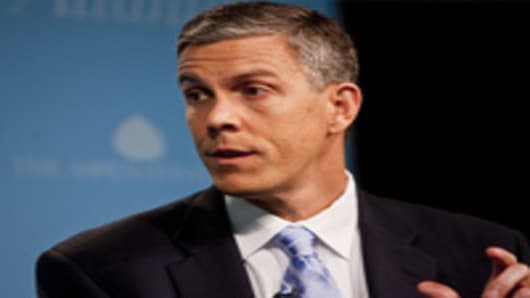Secretary of Education Arne Duncan was all smiles in November as he addressed a group of students at T.C. Williams High School in Alexandria, Va.
“Please apply for our financial aid. We want to give you money. There’s lots of money out there for you,” Duncan said.
The event was the kick-off of a joint push for financial literacy by the U.S. Department of Education, the Federal Deposit Insurance Corporation and the National Credit Union Administration. But implicit in Duncan’s remarks was the fact that nowadays, with costs rising at least twice as fast as overall inflation, saving for college is not enough.
Duncan noted that millions of students do not take full advantage of federal student aid. But the vast majority of that aid consists of loans, and the nation’s student loan debt—and student loan defaults—are going rapidly.
Still, Duncan rejects the notion that the administration is pushing student borrowing in a way that previous administrations pushed home ownership—with disastrous results.
“We have to educate our way to a better economy,” Duncan told CNBC in an interview. “The only way we’ll get to there from here is through many more students not just graduating high school but going to college.”
Duncan is concerned, however, about the rapid rise of college tuition, and hinted the administration is preparing to shame some schools into keeping costs down.
“We’re really trying to shine a spotlight on those places that in tough financial times are holding the line,” he said. “You see some places that have runaway costs. I think that parents and students are going to continue to figure out who’s being thoughtful in tough times and who’s not. And they’ll vote with their feet.”
But despite one of the worst job markets on record for college graduates, Duncan does not believe students should postpone college, or not go to college at all.
“I think they need to go to the right college. I mean, this is all about choice,” he said. “Whether it’s a 4-year university, a 2-year college, trade, technical, vocational training, at the end of the day today, there are no good jobs out there if you just have a high-school diploma.”
President Obama has set a goal of the U.S. leading the world in college graduates by 2020, which Duncan said is essential to global competitiveness.
“Today we’re ninth and we’re paying a huge price for that economically,” he said.
Duncan acknowledged that regaining the top spot will require higher enrollment at all types of institutions, including controversial “for-profit” colleges that have been the subject of a government crackdown.
“The great for-profits, the good for-profits are absolutely part of the solution,” Duncan said. “They’re helping young people, they’re helping single moms, they’re helping people who have struggled to get back on their feet through education and climb the economic ladder.”
But with complaints that some for-profits are luring students into overpriced programs, leaving them saddled with debt and limited job prospects, Duncan has proposed tying the institutions’ aid to the eventual employment of their graduates.
“Where we have huge concerns is where you have for-profits that are misrepresenting the facts, who aren’t being straight, who are piling up students with debt that they can never begin to repay and we’re going to challenge that status quo very clearly,” Duncan said.
The for-profits saythe proposed “gainful employment” rules will force them to cut programs, just when the nation is striving for more higher education. Many of the institutions rely on federal aid—and particularly student loans—for nearly all of their revenue.
With student borrowing and student loan defaults at such high levels, Duncan pointed to the administration’s reforms in the student loan system. Beginning this year, the government began lending directly to students, rather than subsidizing and guaranteeing loans from private lenders. The resulting savings are being funneled into increased Pell Grants—“$40 billion in pell grants without going back to the taxpayers for a dime,” Duncan said.
The reforms also include an income-based repayment plan that allows a student who has not defaulted to reduce his or her payments to 15 percent of their income, though the remaining portion of the loan is considered taxable income.
“While I think there’s a lot of hard work ahead of us, I think we’ve made dramatic changes, dramatic improvements to make college more accessible and more affordable,” Duncan said.
Watch the premiere of "Price of Admission: America's College Debt Crisis," a CNBC Original documentary, Tuesday, December 21 at 9pm ET.




